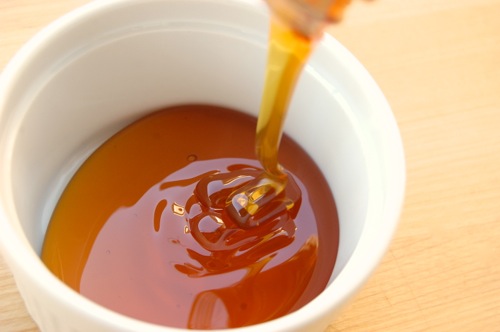Bee Syrup

You can’t talk bee sting cake without talking honey and bees, now can you? Bees are hands down the world’s premier syrup manufacturers. It’s little wonder why, they’ve been refining their technique for about a hundred million years. The process they use is the same one we employ for making syrup out of tree sap or sugar cane: reduction. They start with a thin 80% water-to-sugar solution that they extract from flowers, then slowly reduce it down until it has a moisture content of right around 18%. At that point they deposit the syrup in a cell in the honey comb, cap it off with wax and await the winter (or the beekeeper).
The process by which bees convert nectar to honey is fascinating, and it begins at the moment a honey bee extracts the nectar from a flower. The nectar, which can be made of sucrose, glucose, fructose or any combination, flows into an organ inside the bee called the “honey stomach”. There enzymes go to work on it breaking any sucrose molecules (and other more complex sugars) down into simple glucose and fructose. When the forager bees arrive back at the hive, they pass the nectar to other workers who suck the honey into their own honey stomachs and begin a process of repeated regurgitation. They hold a small droplet of nectar just under their tiny mouth parts, which exposes it to the air, causing some of the moisture to evaporate. They then re-ingest the droplet and do it again. All the while enzymes continue to work on the nectar breaking any remaining long-chain sugars down and converting some of the glucose to gluconic acid (the reason for which I’ll explain in a moment).
After about 20 minutes of this, the worker deposits the nectar — which by this time is down to about 50% water — on the surfaces and the edges of the open honeycomb. There it’s left to evaporate further, a process that’s facilitated by other workers who beat their wings near the front and back entrances to create a steady flow of air through the hive.
Having been a beekeeper (Mrs. Pastry and I used to keep a few hives on top of a building in Chicago) I can say I’ve witnessed this behavior, and it’s awe inspiring. The sound that used to issue from our hives at night rivaled the humming of the HVAC units nearby. When you held your hand out in front of the larger front entrance you could feel the hive’s moist, warm breath as it expelled humidity from the interior.
Once the honey is reduced down to less than 20% moisture, it’s deposited in the comb and capped. The whole process, start to finish, takes about three weeks. The big question is: why do bees do this? Why do they expend so much time and energy creating the 5-1 syrup that the rest of the world knows as honey? The reason is: to prevent their nectar harvest from being plundered by microbes. For indeed syrups much over 20% water will eventually ferment in a warm environment. The concentration of sugar — combined with the gluconic acid I mentioned a few paragraphs ago — is enough to keep honey from spoiling indefinitely.
And when I say indefinitely, I mean it. It’s been reported that an Egyptologist by the name of Theodore Davies found an urn that contained crystallized but still usable honey that was over 3,000 years old. Maybe that’s true, maybe it isn’t, but suffice to say bees can successfully keep their harvest out of the hands of greedy microbes for a long, long time. Now if those poor bees could only do the same with greedy beekeepers…
How did you get to keep bees? I assume that there’s a lot of knowledge involved (apparently, cheers!), but I never came across much of that at all. Did you have friends who trained you, was it self-studying, school or just getting started?
Thanks for the post!
Hey Uptight!
My great pleasure! Mrs. Pastry watched the movie Ulee’s Gold a few too many times and eventually sold me on going to a training course at University of Illinois over a weekend. After that we had a friend who helped us find some used gear. A long time beekeeper, he also gave us tips. There are some books about it, but really it’s not complicated. The main trick is keeping them healthy, which is hard nowadays because of invasive pests and colony collapse disorder. Then of course there’s the not-getting-stung part, which isn’t easy either! 😉
– Joe
In my Egyptology courses in university they talked about the millenias old honey, so I think that’s actually a true story (as far as Egyptologists are concerned, of course 😉 )
Thanks, Katherine!
– Joe
Joe –
There is an old and often-told story about Lord Mackay of Clashfern, the former Lord High Chancellor of Great Britain. Lord Mackay was a member of the “Wee Frees”, those independent Scottish Presbyterians who are great believers in self-denial.
One evening, so the story goes, he hosted a gathering in Edinburgh for the Faculty of Advocates. The guests were served tiny pieces of toast with an equally tiny pot of honey. One guest looked on this meagre spread and said, “Ah, I see your Lordship keeps a bee.”
I’ll be telling that one often, Philip. Thanks!
– Joe